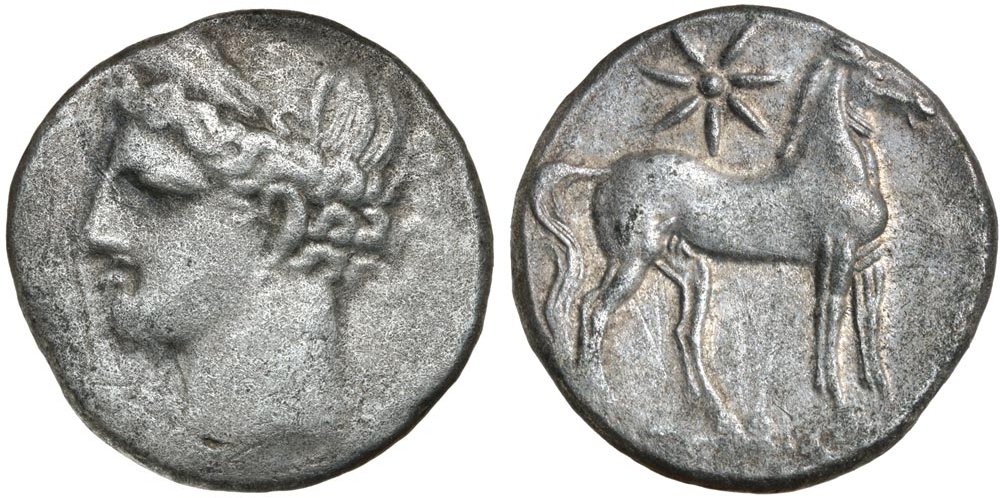S 1570 - Carthage, silver, double shekels (255-241 BCE) Visona
From SILVER
255 BCE - 241 BCE Silver 76,235 kg
Description
| ObverseInscription or printing placed on the obverse.: | Wreathed head of Tanit to left wearing earring and necklace, dotted border |
| ReverseInscription or printing placed on the reverse.: | Horse standing to right, with a large star above horse |
Mint and issuing power
| MintIdentifies the place of manufacture or issue of a numismatic object.: | Carthage | Ancient regionAncient region.: | Zeugitana | Modern countryModern country: Tunisia | AuthorityIdentifies the issuing power. The authority can be "pretended" when the name or the portrait of X is on the coin but he/she was not the issuing power. It can also be "uncertain" when there is no mention of X on the coin but he/she was the issuing power according to the historical sources: | Carthaginian Empire |
Chronology
| FromIdentifies the initial date in a range assigned in a numismatic context. | 255 BCE | toIdentifies the final date in a range assigned in a numismatic context.. | 241 BCE | PeriodTime period of the numismatic object.: |
Physical description
| MetalThe physical material (usually metal) from which an object is made.: | Silver |
Median weightMedian of the weights of numismatic objects (in grams). in grams | 14.50 | DenominationTerm indicating the value of a numismatic object. Examples: tetradrachm, chalkous, denarius.: | double shekel, tetradrachm | StandardStandard.: |
Image

S 1570 - Carthage, silver, double shekels (255-241 BCE) Visona.jpg [1]
References
| Die study referencePublication of the study: | Visona 20061Visona 2006 | ||
| Coin series referenceReference to coin series study: | Alexandropoulos 20072Alexandropoulos 2007, n° 40-42 | ||
| Coin series web referenceCoin series web references: | |||
Obverse dies distribution
| FrequencyFrequency of specimen in distribution. ᵖ | Number of obversesNumber of obverse dies. ᵖ (o) | % (o) | Number of coinsNumber of coins. (n) | % (n) | Die nameName(s) of the die(s). |
| 1 | 37 | 86.05 | 37 | 75.51 | a1, a2, a5, a6, a7, a9, a10, a11, a14, a15, a16, a17, a18, a20, b1, b2, b3, b4, b5, b6, b7, b8, b9, b10, b11, b12, b13, b14, b15, b16, b17, b18, b19, b20, b21, b22, b23 |
| 2 | 6 | 13.95 | 12 | 24.49 | a3, a4, a8, a12, a13, a19 |
| Total | 43 of 43 | 100 | 49 of 49 | 100 |
Reverse dies distribution
no distribution is available
Quantification
| Number of obversesNumber of obverse dies. ᵖ (o) | 43 | Number of singletons (o1)The number of singleton coins. ᵖ | 37 |
| Number of reverse diesNumber of reverse dies. (r) | 50 | Number of coinsNumber of coins. (n) | 49 |
| Coins per obverse dieNumber of coins per obverse die. (n/o) | 1.14 | Coins per reverse dieNumber of coins per reverse die. (n/r) | 0.98 |
| Reverse per obverse ratioRatio of obverse dies divided by reverse dies. (r/o) | 1.16 | Percentage of singletons (o1)number of coins (n) divided by the number of singletons (o1) ᵖ | 86.05 % |
| Original number of dies (O) (Carter 1983 formula)The estimation of the number of coins according to Carter 1983 ᵖ | 262.88 | Coins struck if 20,000 as average productivity per dieCoins made if the average productivity for obverses (according to Carter) is 20,000. ᵖ | 5,257,600 |
| Original number of dies (O) (Esty 2011 formula)The estimation of the number of coins according to the singleton formula in Esty 2011 ᵖ (O) | 351.17 | Survival rate if 20,000 as average productivity per dieSurvival rate if average productivity is 20,000. ᵖ | 0.00001 |
| Coverage (o = % of O) (Esty 1984 formula)Esty 1984 - coverage (% of O) ᵖ (o = % of O) | 24.49% | Die productivity if survival rate 1/2,000Average productivity if survival rate is 1/2,000. ᵖ | 372.79 |
| Weight of silver (in kg) if 20,000 coins per die (O = Carter formula)Carter 1983 * Median weight * 20000 (*10 if gold or electrum) ᵖ | 76,235 kg <br /> 76,235 kg | Die productivity if survival rate 1/5,000Average productivity if survival rate is 1/5,000. ᵖ | 931.98 |
Remarks